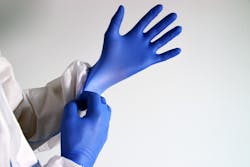Cross-contamination due to lack of glove changes at COVID-19 testing centers resulted in high rate of false positive results
A new study showed that due to the lack of glove changes at COVID-19 testing centers in Belgium led to major cross-contamination of samples and a high rate of false positive results.
The research was presented and reported by the European Congress of Clinical Microbiology & Infectious Diseases (ECCMID).
The introduction of large-scale PCR testing for COVID-19 presented a number of logistical challenges, including a scarcity of personnel adequately trained to do nasopharyngeal swabbing. Research from a government-funded lab in Belgium has identified inadequate PPE management in testing centers as a source of major cross-contamination.
Scientists at the COVID-19 Federal Platform, Department of Laboratory Medicine UZ Leuven, Leuven, Belgium were alerted to the problem in September 2021 when they noticed that 70% of samples taken that day at a testing center in Flemish Brabant, Flanders, had tested positive for COVID-19. The average positivity rate at the time was around 5-10%.
90% of the positive samples had a very low viral load, which hinted that they had been contaminated with the SARS-CoV-2 virus, rather than being true positives. The patients’ results were immediately withheld and a root-cause analysis (an investigation into the cause of the spike in positive samples) carried out.
Lead researcher Bram Slechten says: “After excluding lab contamination we arranged the results from that day in chronological order by time of sample collection. We saw that no one had tested negative after a sample was collected from a patient with a very high viral load and immediately contacted the test center. This led to lack of glove-changing, in combination with high-paced sample collection by a new swabber and the breaking of a swab in the tube, being identified as the likely source of the contamination.
“Protocols at this test center were sharpened overnight and all the patients whose results were withheld were recalled for a new sample the next day. 100% of them were negative.”
Analysis identified potential cross-contamination events in 73% (8/11) of the test centers. The percentage of samples suspected of being wrongly reported as positive widely varied per day and per center.
“If the staff didn’t change gloves between each patient, it was almost certain that contamination would occur,” says Slechten. “We identified four reasons why changing of gloves didn’t happen: it was simply not in the protocol; correct protocol was in place but it was not followed due to lack of training of new members of staff; not having the right size of glove available; work pressure, some swabbers had to sample one patient every two minutes.”
“Furthermore, each false positive generates high-risk contacts who may also need to be tested, increasing the burden for labs, testing centres and contact tracing, he continued.He believes the false positives artificially inflated the COVID-19 case numbers for Belgium. He says: “It is hard to put a number on, however, because we saw a lot of differences between the test centres we studied. In addition, we only looked at test centres in one part of Belgium, making it hard to get the whole picture. “It is very probable that this also occurred in other countries.
